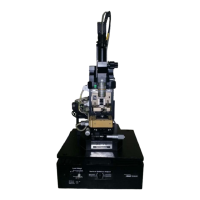
Do you have a question about the Park Systems XE-70 and is the answer not in the manual?
| Type | Atomic Force Microscope (AFM) |
|---|---|
| Z Range | 15 μm |
| Techniques/Operating Modes | Contact, Non-contact, Tapping, Electric force microscopy (EFM), Magnetic force microscopy (MFM), Conductive AFM |
| Sample Size | Up to 200 mm diameter |
| Vibration Isolation | Active vibration isolation system |
| Acoustic Noise Isolation | Acoustic enclosure (optional) |
| Power Requirements | 100-240 VAC, 50/60 Hz |
| XY Sensor | High-resolution capacitive sensor |
| Z Sensor | High-resolution capacitive sensor |
| Detector | Position sensitive photodetector (PSPD) |
Step-by-step guide for connecting and preparing the AFM hardware.
Locate and focus the optical microscope on the cantilever.
Adjust Mirror 1 to direct the laser onto the cantilever tip.
Solutions for when the Z-scanner fails to detect the surface during approach.
Additional steps if a good image cannot be obtained, including auto-setup and tip replacement.
How to flatten AFM images to remove sample tilt or curvature.
